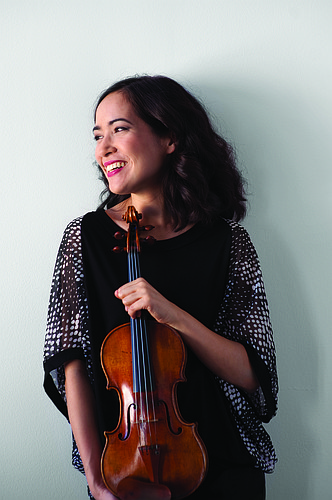- January 14, 2025
-
-
Loading

Loading

Last week’s Masterworks 5 concert was themed “Round Trip to Paris” and featured guest conductor Clark Rundell and violin soloist Viviane Hagner in works by American and French composers.
Violinist and composer Henri Vieuxtemps wrote his Fifth Violin Concerto as a competition piece for the Brussels Conservatory, and as such, it relies more on technical feats than actual musical values.
Hagner is an excellent violinist, playing with a brilliant, focused sound, and she was certainly up to the technical challenges of the concerto. In the lyrical second movement the theme is based on an operatic aria by Grétry, in which she spun a beautiful melodic line.
After intermission, Hagner returned with the out-and-out virtuoso “Introduction and Rondo Capriccioso” by St. Säens, written especially for the Spanish violin virtuoso Pablo de Sarasate. Here we had musical substance and pyrotechnics, and both were handled with great aplomb.
Conductor Rundell kept a beautiful balance between soloist and orchestra, and proved to be an excellent accompanist.
Other works on the concert were by American composers, two of whom wanted desperately to be known as “serious” composers, while their reputations were largely made on Broadway and movie scoring. Of course these two were George Gershwin and Leonard Bernstein, with Samuel Barber already firmly ensconced in “serious music.”
Gershwin’s “American in Paris” opened the concert and was presented in the “original 1928 version,” the result of a lot of research and reconstruction.
Conductor Walter Damrosch commissioned the piece and then deleted some 112 bars of music before the first performance. Research also indicated that the tuned taxi horns turned out to be different than those originally used by Gershwin, and also changes had been made in the saxophone writing.
And just how noticeable are all these reinstatements to the average concertgoer? Well, the taxi horns are both a bit louder and lower in pitch, and the additional saxophone writing adds a great deal to the mellowness of the sound. But I’m not completely sold on the restoration of the 112 bars of music. It’s basically a repetition and development of the “blues” theme, which is refreshing to hear, but in the end really doesn’t add that much, at least to my ears.
Having said all that, the performance by Rundell and the Sarasota Orchestra was outstanding in style, musicianship and execution. The orchestra obviously enjoyed playing the piece, all the solos were beautifully played, and the audience loved it.
Samuel Barber’s “Night Flight” is his musical depiction of a World War II pilot returning to his home airfield in the dark of night after a successful mission.
Beautifully stated by Nicholas Arbolino’s English horn, Barber’s initial theme emerges over the lower strings, accenting the loneliness and darkness of the night. “Night Flight” was written in 1944, some eight years after his famous “Adagio for Strings,” but it has much the same structure of building tension and ultimate release — here with the single note of a clarinet as the homing beacon, guiding the pilot safely to his home base.
Rundell and the strings achieved a great beauty of color and sound, matched by the winds as the anxiety increased, then subsided, as both pilot and the music said they would be safely home.
Bernstein wrote only one film score, but “On the Waterfront” is a remarkable piece of, yes, “serious” writing. It underscores and heightens the drama on the screen as it would in his later theater works of “Candide” and “West Side Story.”
It is a gutsy movie with a gutsy score, from the opening notes of Joshua Horne’s French horn solo through Don Rhynard’s saxophone solos, the massive “percussion concerto” depicting the longshoremen’s battle, to the love theme and ending.
Yes, there were hints of Aaron Copland, who was Bernstein’s “unofficial and only” composition teacher, and another or so of “West Side Story,” yet to come, but the “love theme” had bold hints of the yet-to-be-realized final chorus of his “Candide,” which moved me the most in this outstanding performance of Bernstein’s movie score.
Yes, it was a wonderful “Round Trip to Paris,” indeed.